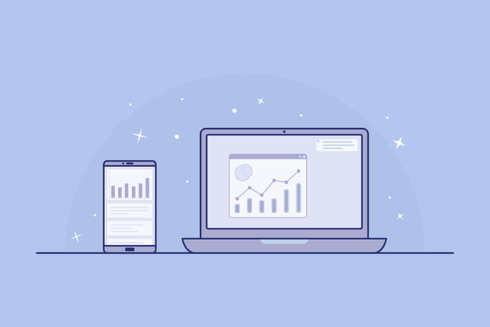
It is common knowledge that the volume of data in existence is increasing exponentially, and many organizations are starting to struggle with the best way to cope with it. This trend will only accelerate with the rapid development of IoT, which according to IDC will generate 79.4 zettabytes (ZB) of data in 2025 from 41.6 billion connected IoT devices.
Having this amount of data may seem daunting to many, and though every business will make mistakes every now and again, everyone should strive to minimize those mistakes. They should also strive to ensure exemplary customer experience in every interaction, and this is where all that data becomes useful. Predictive analytics helps companies to anticipate the future, enabling them to increase the likelihood they are meeting customer expectations while preserving and improving the customer experience.
Predictive analytics: what exactly is it?
Predictive analytics is the practice of analyzing data in order to predict future trends. Using this, organizations can discover better ways to serve customers and determine how many items to keep in inventory or detect fraud as it’s occurring, for example. Predictive analytics combines several data analysis techniques, including machine learning, data mining, statistics and artificial intelligence to analyze data and develop an understanding of how past actions and behaviors can impact future outcomes.
RELATED CONTENT: Is DataOps the next big thing?
In the business world, predictive analytics is rapidly gaining momentum because when businesses execute predictive analytics effectively, they become more agile, more efficient and – most importantly – more profitable.
Despite this, the current uptake of predictive analytics is still not that high partly due to a few main obstacles. In this age of cloud computing, businesses collect and store more data than ever before. As a result, it becomes more difficult to create machine learning algorithms that can effectively answer questions and discover new opportunities.
The rise of predictive analytics may suggest that business analytics overall will be improved, but that’s not always the case. In reality, few companies are able to successfully make sense of all the data they’re collecting. This is largely because the technology required to interpret the data is complex and resource intensive. Additionally, many organizations struggle with data silos. A company might have the perfect data set, but if it’s hidden away in some unknown repository it provides very little value to the business.
Regardless, some companies are still moving forward with predictive analytics, and therefore, it’s key to understand how it works.
The tricks behind the technology
Predictive analytics begins with a predictive model that uses an understood outcome (for example, a customer purchase) to determine what might happen in the future. This model inspires the development of a new model. For instance, one model might predict future customer purchase behaviors, and the next model could be used to predict future outcomes in relation to additional input variables (such as time of day or weather).
There are various types of techniques and models:
- Decision Trees – A visual chart that resembles a tree and demonstrates the likelihood of every potential outcome of a decision.
- Regression Algorithms – Can predict a numerical value, such as how many days will pass before a customer makes a repeat purchase. It also can predict how much money a customer will likely spend on a future purchase over a certain period of time.
- Neural Networks – Also known as Artificial Neural Networks (ANN), these are highly advanced data processing techniques modelled after the human brain. ANNs are behind today’s most advanced technologies, including facial recognition and text-to-speech software.
- Classification Algorithms – Can predict whether the subject in question is a member of a specific group or not. For example, a classification model could be used to predict whether a website visitor is going to be an immediate buyer or if they are just browsing.
Easy as 1-2-3
Businesses are now racing to implement predictive analytics because it provides a number of benefits that fast-moving organizations can’t live without.
- Lower Costs – Businesses that can predict customer demand more accurately can reduce costs by having the right amount of inventory on hand. Furthermore, when a business understands who its ideal customer is, it can use that data to better target its marketing campaigns towards that ideal customer.
- Better Fraud Detection – In an age of ever-increasing cybersecurity threats, predictive analytics helps businesses detect malicious activity across their web platforms. Without delay, businesses can react to these threats and protect themselves before damage is done. Through this, predictive analytics can save a considerable amount of money while keeping customer data secure and brand integrity intact.
- Increased Efficiency – Predictive analytics can also be used to increase business efficiency. By analyzing seasonal and historical data and considering other influential factors, companies can discover when the busiest times of year are (e.g. an airline could predict peak times for ticket sales). A business that can predict what customers want can have their products ready the moment they want them. With this efficiency, customers are more likely to buy again.
Predictive analytics has a wealth of real-life uses that most people may not consider. For example, navigation devices like a car’s GPS system, your smartphone’s navigation app or your favorite airline’s in-flight computer system. When any of these devices offers a prediction of your arrival time, that’s predictive analytics in action. Or in the healthcare industry, predictive analytics is already being used to improve health outcomes.
Companies can’t make the best decisions when they’re basing them on gut instinct. Wherever possible, IT decision-makers need to be as informed as possible on the latest innovative technologies – such as predictive analytics – to ensure that they can make the best choices for their business. With this level of data analysis, IT teams will have greater insights into all of the intricacies of their data and will be better able to deliver the services that customers need. In reality, nobody knows what the future will entail, but with predictive analytics, businesses can make a good guess at what tomorrow holds.






